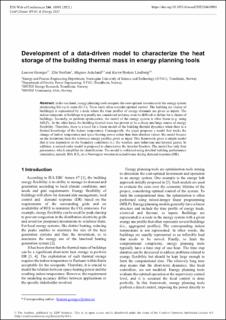| dc.contributor.author | Georges, Laurent | |
| dc.contributor.author | Storlien, Elin | |
| dc.contributor.author | Askeland, Magnus | |
| dc.contributor.author | Lindberg, Karen Byskov | |
| dc.date.accessioned | 2021-04-04T19:33:51Z | |
| dc.date.available | 2021-04-04T19:33:51Z | |
| dc.date.created | 2021-04-03T17:09:51Z | |
| dc.date.issued | 2021 | |
| dc.identifier.citation | E3S Web of Conferences. 2021, 246 . | en_US |
| dc.identifier.issn | 2267-1242 | |
| dc.identifier.uri | https://hdl.handle.net/11250/2736259 | |
| dc.description.abstract | In the one hand, energy planning tools compute the cost-optimal investment in the energy system minimizing life cycle costs (LCC). These tools often consider optimal control. The building (or cluster of buildings) is represented by a node where the time profiles of energy demands are given as inputs. The indoor temperate in buildings is typically not considered and may even be difficult to define for a cluster of buildings. Secondly, to perform optimization, the model of the energy system is often linear (e.g. using MILP). In the other hand, the building thermal mass has proven to be a cheap and large source of energy flexibility. Therefore, there is a need for a linear model of the building thermal dynamics when there is a limited knowledge of the indoor temperature. Consequently, the paper proposes a model that tracks the change of indoor temperature and space-heating power rather than their absolute values: the model focuses on the deviations from the reference energy profiles given as input. This framework gives a simple model that is less dependent on the boundary conditions (i.e. the weather, user behaviour and internal gains). In addition, a second-order model is proposed to characterize the transfer function. The model has only four parameters, which simplifies its identification. The model is validated using detailed building performance simulation, namely IDA ICE, on a Norwegian wooden detached house during demand response (DR). | en_US |
| dc.language.iso | eng | en_US |
| dc.publisher | EDP Sciences | |
| dc.relation.ispartof | Cold Climate HVAC & Energy 2021 | |
| dc.rights | CC BY 4.0 | * |
| dc.rights.uri | http://creativecommons.org/licenses/by/4.0/ | * |
| dc.title | Development of a data-driven model to characterize the heat storage of the building thermal mass in energy planning tools | en_US |
| dc.type | Peer reviewed | en_US |
| dc.type | Journal article | en_US |
| dc.description.version | publishedVersion | en_US |
| dc.rights.holder | © 2021 The authors | en_US |
| dc.subject.nsi | VDP::Teknologi: 500 | en_US |
| dc.source.pagenumber | 10 | en_US |
| dc.source.volume | 246 | en_US |
| dc.source.journal | E3S Web of Conferences | en_US |
| dc.identifier.doi | 10.1051/e3sconf/202124610001 | |
| dc.identifier.cristin | 1902026 | |
| dc.relation.project | Norges forskningsråd: 257660 | en_US |
| dc.source.articlenumber | 10001 | en_US |
| cristin.ispublished | true | |
| cristin.fulltext | original | |
| cristin.qualitycode | 1 | |

